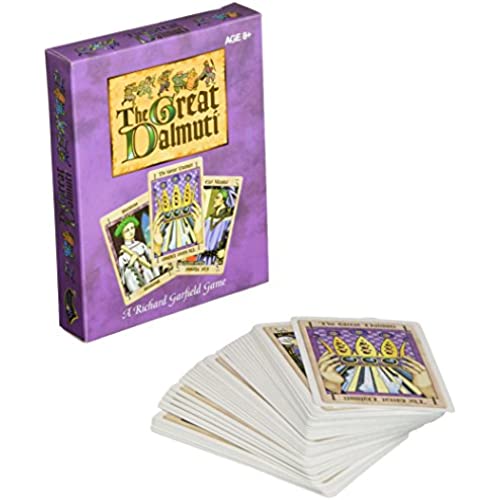

The Great Dalmuti
-

Sportzchck
> 3 dayI have been playing this game since I was a kid. Great game to teach to friends who speak a different language, this game has traveled the world with us.
-

bonnie
> 3 dayMy kids are hooked on this game! We play it all the time. There’s a lot of strategy involved, but very easy to figure out. Definitely for older kids and adults.
-

JT
> 3 dayThe perfect number of people to play this game with a full deck is 7. You have the Great Dalmuti, the lessor Dalmuti, three merchants, lessor peon and greater peon. This game is SO FUN. And you can play it with less players, just follow directions for removing some cards from the deck. This game is great when you have set seats for the different ranks and give the GREAT Dalmuti a special hat of some sort. Its easy to learn, and there is definitely a strategy that can help someone with the worst hand change their position. I love to play it.
-

Shawn
> 3 dayI really do enjoy this game. Specifically for larger 6+ people groups its a 5 star card game. The instructions do mention reducing the deck for smaller groups. But the real joy comes from bringing in new players, in larger 6+ groups. The card face designs are excellent. Yet in general its a 4 star card game as I have found our family often doesnt choose this game when its only 3 to 5 players. And with any size of group, the outcome of each game is often the same. Which causes 2 things to happen for us. Either we keep playing and eat a lot of time because we really want to change rank, or we get frustrated in the lack of rank movement and stop quickly. As a comparison, the more commonly known card game UNO, tends to have a much more varied winner result and is more time controlled by the number of players and deck size. This game is still time controlled by deck size and group size; but the winner results tend to be a little flat for variation. Overall, an excellent card game for any collection and covered the large group player size nicely.
-

K Brookins
> 3 dayFun game. Easy to play
-

Natcanela
> 3 dayMy family and cousins all get together and play this game every holiday. Absolutely love it! Sometimes we play with two decks. One suggestion: Play that you can match. Makes the game more interesting, and more wildcard as to who will win.
-

P. Moody
Greater than one weekIve played this with friends for quite a long time, but finally got my own deck. This game is a blast. But 4 players minimum. Not even sure were playing to the book, since Ive played it for so long (going to have to look into that). But its always been fun and easy to get new people playing.
-

elku
> 3 daylots of family fun
-

Mongo65
> 3 dayBest game on the planet, bar none. And when it comes to Dalmuti cards, GET THESE, they rock! Seriously, I cant say enough about the quality, both in feel and appearance. Ive introduced this game to many friends and family and given many my own deck and gotten another for myself, thats how much I love this game!
-

LMat
> 3 dayWe play this as a family and enjoy hours of entertainment.
